
The magnificent colors of the veiltail betta make it a highly popular tropical fish. This freshwater fish is one of many different species of betta fish.
The betta is also known as Siamese fighting fish, due to the highly aggressive nature of the male of the species.
TABLE OF CONTENTS
Veiltail Betta Facts & Overview

There are many different varieties of betta fish. While there are currently approximately 15 known varieties, this number is constantly changing, as new varieties are being bred and introduced.
The veiltail betta is one of the most popular varieties of betta. Its biggest attraction is its spectacular coloring, which is so eye-catching that it stands out from all other fish.
The scientific name of the veiltail betta is the Betta splendens. It is often just called the betta fish. It belongs to the family of Osphronemidae. These are all freshwater fish.
The veiltail was given its name because of its shimmery, translucent tail that looks almost like a thin piece of shiny fabric.
Like all other bettas, the veiltail betta has a labyrinth organ. This unusual organ differentiates the betta from other fish, enabling it to breathe in oxygen while on the surface of the water. However, like most other fish, the VeilTail Betta also breathes underwater, through its gills.
The male veiltail betta is known to be mildly aggressive, though not as aggressive as many other betta varieties. It is in his nature to turn on other fish of the same species. This is why bettas are often also called Siamese fighting fish.
The betta species is native to some parts of Southeast Asia. It is commonly found in vast areas of Thailand, Cambodia, Indonesia, and Vietnam.
Thailand was formerly known as Siam. Hence the name Siamese Fighting Fish. Siam became Thailand in 1939, but the name Siamese Fighting Fish remains to this day.
Typical Behavior
The male veiltail betta is known to be quite aggressive. If he thinks that his territory is under threat of being invaded, he will turn on any other male betta that appears to be in his space.
It is sometimes a good idea to give the male veiltail betta his own tank, as these solitary fish are often happiest with their own company.
However, this does not mean that you can never keep any other fish together with your veiltail betta in a shared aquarium. You can, but you should give careful consideration to his tank mates, and choose other fish that the veiltail betta will not consider to be a threat to his territory.
In order to establish whether or not your veiltail betta is content in his tank, take a look at his fins. When he is happy and at ease, his fins will be loose and flaccid, waving about freely in the water.
However, if he is holding his fins in a stiff and taught position, it is likely to be an indication that he is feeling threatened and endangered. This could mean that he is preparing to attack his tank mate.
Gentle, calm swimming movements are an indication that your veiltail betta is feeling relaxed, happy, and comfortable.
However, if he is swimming around very rapidly, and appears to be moving frenetically, rushing from one side of the tank to the other and back again, bumping into things along the way, he is probably feeling very stressed and anxious.
Appearance
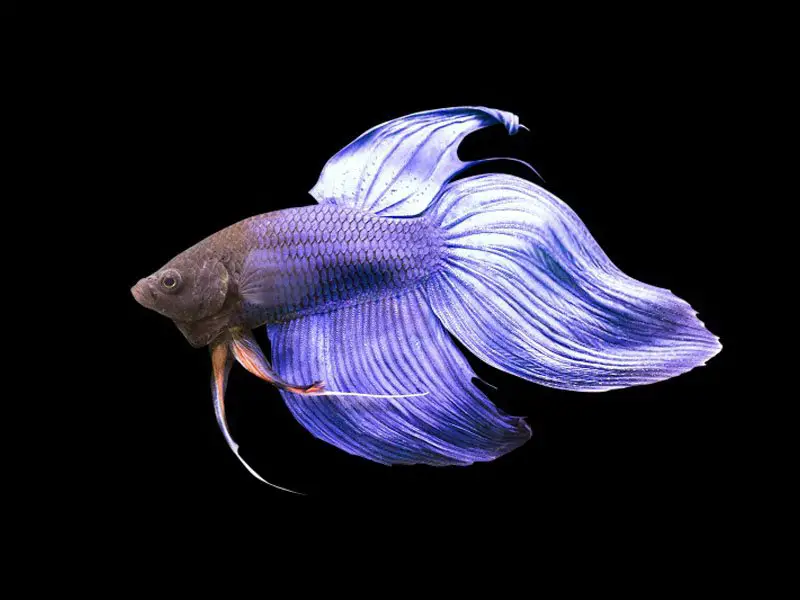
The veiltail betta is so popular because of its exquisite appearance. This is mostly due to the strikingly bright colors of this tropical fish.
They are commonly found in a broad range of bright colors. The most common colors are bright royal blue and turquoise, but you will also find them in emerald green, fire-engine red, bright yellow, orange, and deep purple.
No matter the color, the veiltail betta is always very shimmery, with an almost iridescent sheen to their bodies.
It is not unusual to see that the males often have brighter colors, while the colors of the females are sometimes less vibrant and more subdued.
Occasionally you may notice that your veiltail betta seems to be changing color. This is not a good sign. It could be an indication that your fish is feeling stressed, or even becoming ill. Often the onset of disease causes their bright, shiny hue to fade to a dull shade.
The veiltail betta is not a very big fish. A fully grown adult male will not be longer than 2½ -3 inches, while a female may be even smaller.
Habitat and Tank Conditions
Because the veiltail betta, like all other varieties of betta, originates from the rivers and marshes of Southeast Asia, it is not accustomed to extreme water temperatures. It likes mildly warm water.
The waters of the rivers in Southeast Asia are usually slow-moving to almost still, with very little current. The veiltail betta likes aquarium water that mimics these conditions. Therefore you should avoid using a pump that will introduce a very strong current. Your veiltail betta will not like it.
Tank Conditions
It is important to maintain moderate water parameters for your veiltail betta. This will ensure that your fish is comfortable and content.
This species does not do well in very cold water. If the water is below 70°, your veiltail betta may start becoming lethargic and inactive. It could also cause him to become seriously ill.
This tropical fish will thrive in water that is ideally between 72° and 81° Fahrenheit. The perfect temperature for your veiltail betta would be 75° Fahrenheit.
It is very useful to have a water heater. This will help you to maintain the temperature at a steady level, without any drastic fluctuations.
Using a water heater eliminates the need for guesswork, which is often not accurate. Water heaters are readily available from most aquarium supply stores and they are not terribly expensive.
The veiltail betta has a beautiful tail and fins, but these are very delicate. They cannot cope with strong currents in the water. The current may damage their fragile tails and fins. Therefore the water movement should only be kept to a minimum, with a gentle flow and mild current.
The General Hardness, or GH, of the water, is important. The veiltail betta will not do well in water that is too hard. They prefer to have soft water in their aquarium, with a dGH, or degree of General Hardness, of between 5 and 20.
A moderate pH level is essential in the water of your aquarium. The veiltail betta cannot tolerate extremely acidic or alkaline water. A pH level of between 6.8 and 7.5 will keep him healthy and happy.
Having the correct lighting in your aquarium will not only enhance and bring out the best in your veiltail’s striking colors, but it will also keep your fish comfortable.
Veiltail bettas like to have plants in their tank. These give them places to swim around and hide. The plants will need light in order to live and grow.
Take care when selecting plants for your veiltail betta’s aquarium. They should be very soft and pliable, in order to avoid them tearing and damaging the VeilTail betta’s delicate tail and fins.
Your veiltail betta will enjoy having a few rocks in his tank. He loves hiding in small, concealed spaces and crevices, and rocks will give him some good hiding places. But the rocks should be smooth, with no sharp or jagged edges that can harm your fish.
What Size Aquarium Do They Need?
The veiltail betta is a very active little fish, and therefore it needs a fair amount of space. If you are considering getting a fishbowl to house your veiltail betta, that is not a good idea. He will not survive in such a small space. It needs a tank with a minimum of 4 gallons for a single fish.
In a tank of this size, he will have sufficient room to swim around freely and comfortably. If you intend to add other fish to the tank, you will need an even bigger size. The veiltail betta needs to have enough space to keep its distance from other fish in its tank.
Tank Mates
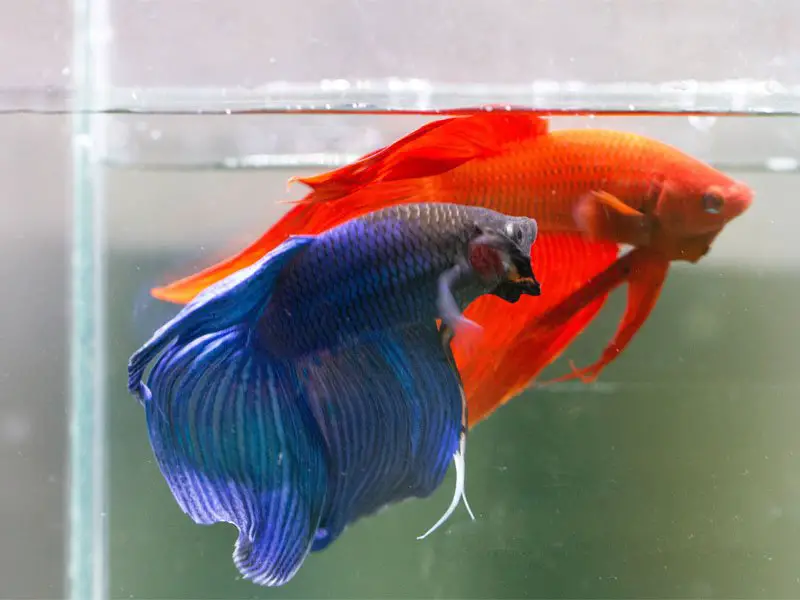
While the male veiltail betta is not quite as aggressive as most other betta varieties, he does still have aggressive tendencies.
If he is paired with other bettas, of any variety, he will perceive them as a threat and he will most probably display aggressive tendencies towards them. Therefore, it is not advisable to place these in his tank.
It is possible that your male veiltail betta will tolerate and maybe even enjoy the company of another female betta, but you will have to keep a very close eye on them to see if they are compatible.
It is recommended to select very placidly, non-aggressive species of small fish to share a tank with your veiltail betta. Some of the species that are recommended as tank mates for a veiltail betta are cory fish, guppies, kuhli loaches, and ghost shrimp.
These should all be compatible with your veiltail betta and they should be able to get along with each other in a shared tank, without any major social problems.
Diet
The veiltail betta is a carnivore, like all other betta varieties. Therefore his diet should include a variety of mainly meaty foods.
Live food is the best choice for his carnivorous diet. He will enjoy eating both live and frozen bloodworms and brine shrimp, as well as live mosquito larvae.
The veiltail betta can also be fed freeze-dried food, as well as fish food flakes or pellets. These should be good quality fish foods that have a high protein content.
Take care not to fall into the trap of overfeeding your veiltail betta. It is so easy to give too much food. Overfeeding will make your fish bloated, constipated, and very sick. It may even kill him.
These fish are very small, and as such, they only require minute quantities of food. However, they do need regular feeding and should be given two meals a day, spaced about 12 hours apart.
Your veiltail betta will soon learn your feeding schedule and will know when to expect food. Therefore you should try to stick to a regular feeding routine and offer food at the same time every day.
Care
The veiltail betta is not a difficult variety of fish to look after. It does not need intense care from you, and you can mostly follow standard betta fish care. The most important aspect of its care is that its water parameters should be correctly maintained as per the above guidelines.
The most time-consuming aspect of caring for the veiltail betta is keeping his tank clean. Like all tropical fish, the tank needs to be cleaned regularly. This should be done at the barest minimum of once every two weeks.
When cleaning the tank, the gravel should be siphoned and about 10% of the water replaced.
If the tank is not kept meticulously clean, algae and other harmful organisms can build up very quickly. These can be very damaging to your fish, and may eventually kill it.
It is recommended that you do regular checks to test the levels of the minerals in the water. Elements such as calcium, strontium, magnesium, and other trace elements should be kept at a steady level.
It is possible to test these mineral levels by using an aquarium testing kit. When a deficit or imbalance in the mineral levels is detected, this should be adjusted immediately.
Breeding the Veiltail Betta
The veiltail betta has a dominant gene and can be bred without too much difficulty. This is the most popular variety of the betta species and is the type that is most commonly found in aquarium pet stores.
The veiltail betta will be ready for breeding once he reaches about 6 months of age. Earlier than this, their bodies are not yet mature enough to cope with breeding, and any attempts at breeding are not likely to be successful.
In order to encourage successful breeding, it is recommended that the breeding pair be given their own tank. They are unlikely to mate in the presence of other fish in the tank.
When pairing up 2 veiltail bettas for breeding, the female must be slightly smaller than the male. If she is the same size as him, or bigger than him, he may feel intimidated by her and will not approach her.
The female changes color slightly when she is ready for mating. Her color will become darker, and she will develop noticeable stripes down her body.
The female’s ovipositor also becomes clearly visible when she is ready for mating. You may notice this as a white dot between her fins.
The female veiltail betta will start to behave in a flirtatious way towards her mate when she is ready to receive him. She may start acting coyly, by waving about and flaring her tali in his direction. These are her mating signals.
All female betta fish have an unfortunate habit of attempting to eat their own eggs, and the veiltail betta is no different in this regard.
The only thing that you can do to prevent this behavior is to ensure that the eggs have lots of little crevices to settle in, where they are inaccessible to the mother fish.
These crevices are best created by using a substrate of gravel and perhaps adding a few marbles to the substrate. This gives the eggs places to hide in safety until they can hatch.
Is the Veiltail Betta Suitable for Your Aquarium?
The veiltail betta may have certain requirements in terms of its maintenance, but it is not a difficult fish to care for. If you want to keep one of these magnificent-looking fish in your aquarium, there is no reason why you should not be able to.
The water parameters need to be maintained at the correct level, and it is important to follow the guidelines given for the correct tank conditions.
The veiltail betta does not have a terribly long life expectancy, but if you adhere to the recommendations given in this article, you should be able to keep a v in your home aquarium for a few years.
As long as your freshwater aquarium is big enough for a veiltail betta to swim around freely, it should be quite happy.
If you can ensure that it is only paired with suitable tank mates that would be compatible with the veiltail betta, this beautiful-looking fish, with its bright colors, will be an exciting and welcome addition to your tank.


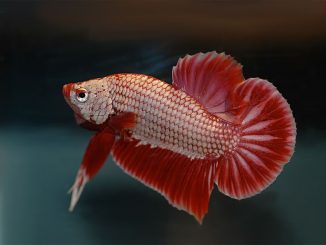
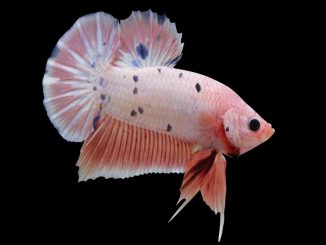

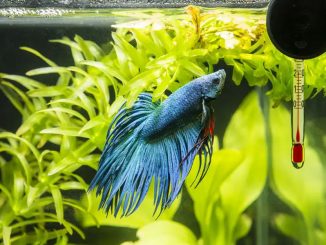
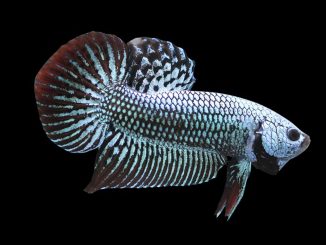
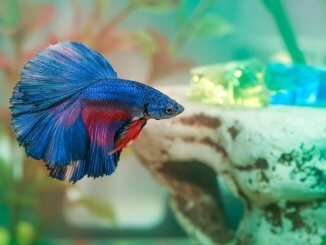
Be the first to comment